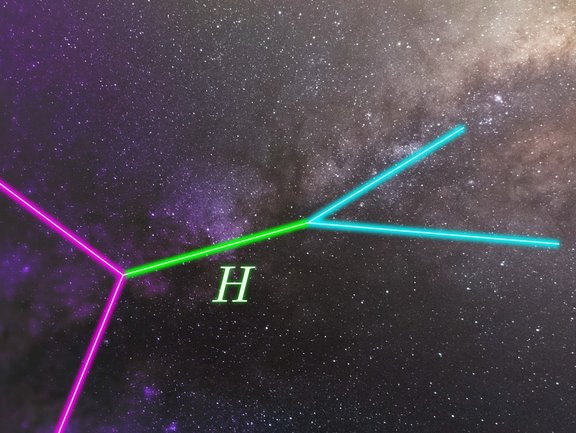The large-scale motions of all visible objects in the Universe are dominated by the gravitational force. From these motions one can determine the amount of mass causing it. Looking for instance at the rotation of stars in galaxies, it becomes clear that there is a discrepancy between the motion of the stars at the galactic fringes and the gravity caused by the stars and gas within the Galaxy: The stars at the outer edges rotate so fast that they cannot be held together by the gravitational pull of visible matter alone.
An explanation for this phenomenon is the presence of much more matter in the Universe – specifically invisible matter that cannot be observed by electromagnetic waves. This Dark Matter contributes up to 5 times the mass of visible matter in the Universe and we do not know what it is made of. This is one of the big open questions in physics today.
Dark Matter could consist of rare relic particles left behind from a once-abundant population in the hot early Universe. Theoretical physicists work to derive ways to test this hypothesis, predicting particle physics processes we can strive to observe in the lab or the Galaxy.
MPIK scientists Johannes Herms and Sudip Jana, together with colleagues, now present a novel model for light Dark Matter, with promising implications for identifying this currently unknown component of the Universe.
Traditionally, these so-called ‘thermal relic Dark Matter’ particles were expected to have masses comparable to that of the famous Higgs boson, i.e., are rather heavy. In contrast, the current work presents a particularly simple scenario for lighter Dark Matter. It is based on the realisation that there may exist a second kind of Higgs particles, with mass comparable more to the mundane electrons or protons. This second Higgs is a novel possibility how light Dark Matter may attain the density we observe today through annihilation reactions in the early Universe. A central prediction of the thermal relic scenario is that such annihilations are still going on in galaxies today. While in the new model problematic direct annihilation is ‘forbidden’ by energy conservation, we find that annihilation at the quantum level will lead to a distinctive signature in the gamma-ray spectrum.
How do we find out whether anything like the scenario envisioned here is realised in nature? Surprising experimental results regarding the magnetic moment of muons (heavier type of electrons) and the mass of the W-particle (mediating the weak nuclear force) may be hints for a lighter kind of Higgs. More concrete evidence could show up soon in the form of new heavy charged particles at the Large Hadron Collider. The smoking-gun signature of this minimal realisation of light thermal Dark Matter, however, would be if next-generation intermediate-energy gamma-ray telescopes would see an annihilation line in the gamma-ray spectrum of the centre of the milky way.
Original publication:
Minimal realization of light thermal Dark Matter, Johannes Herms, Sudip Jana, Vishnu P.K., Shaikh Saad, Phys. Rev. Lett. 129, 091803, DOI: 10.1103/PhysRevLett.129.091803
